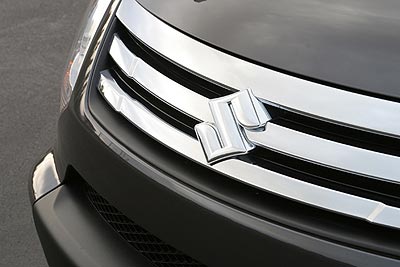Recent Articles
Popular Makes
Body Types
2007 Suzuki XL7 Review
The last child from a troubled marriage
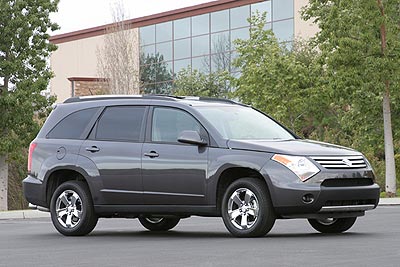
Suzuki XL7 – 2007 Review: Suzuki’s motorcycle heritage is something to be proud of, and the company wants you to think that its various non-motorcycle vehicles have the same DNA. In the case of the 2007 Suzuki XL7 crossover, don’t believe the hype. The product of an ultimately failed relationship between Suzuki and General Motors, the XL7 is a reskinned and stretched Chevrolet Equinox. The result is a mixed bag of old and new GM thinking and Suzuki’s best efforts to make a silk purse out of, well, you know. For example, the strong engine is too noisy, and the comfortable interior suffers from numerous quality issues. At more than $30,000 it’s also ridiculously overpriced, even with a class-leading warranty.
What We Drove
This Suzuki had a sticker price over $30,000, a price at which many superior vehicles are available. Our XL7 Limited test vehicle boasted three seating rows and front-wheel drive, giving it a base price of $27,949. Included in that price was a 3.6-liter V6 engine and five-speed automatic transmission, anti-lock brakes, stability control and traction control, automatic front climate control, leather interior, and fog lights. The $2,200 Platinum Touring package added a touch-screen navigation system, a sunroof which eliminates the rear-seat DVD entertainment system, and chrome 17-inch wheels. The XM satellite radio was $300 with a $300 credit, so the out the door price was $30,149.
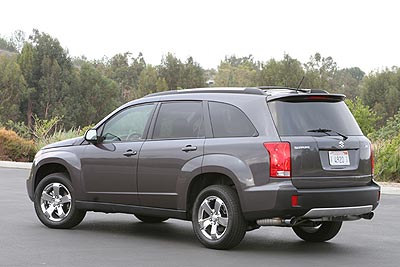
Performance
The XL7’s engine is strong. With 252 horsepower and 242 lb.-ft. of torque, it is smooth and responsive, and the automatic reacts quickly whether you’re doing the shifting in manual mode or if you let the computer do the work. We’d wax poetic if the powertrain wasn’t so damn noisy. There’s constant – and we mean – noise at every engine speed except idle, with the engine droning or wailing or grumbling or growling. Enough already! There’s also some annoying torque steer. It’s a shame because it’s a good powerplant, but General Mo…rather, Suzuki…really needs to work on its aural tuning for this engine. Improving on our test car’s 16.5 mpg fuel economy would also help.
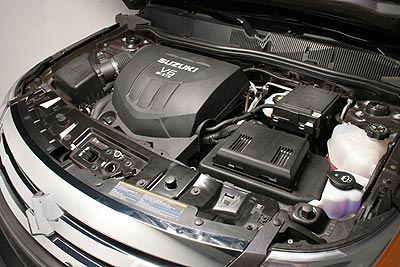
Handling
The XL7 won’t let you slide into a ditch, but neither will it wow you with its handling. Our front-drive test car was marred by torque steer and a serious understeering habit; the all-wheel drive version would surely eliminate the former and mitigate the latter. On the road the XL7 is a decent companion. The ride quality is good, the body motions are well damped, and overall it’s pretty comfortable in the daily grind. The steering ratio is quick, but it’s completely numb and the turning circle is large. We were surprised to hear the occasional thunk from the suspension over rougher surfaces, and hope it’s indicative of a test car abused by others rather than a quality issue.
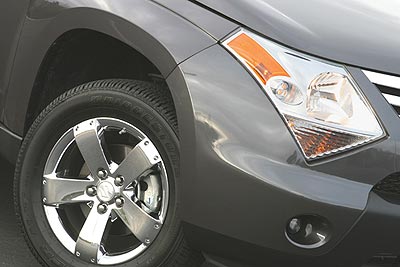
Visibility
Front visibility is good. The front and side pillars are thin and easy to see past, and the rear headrests don’t jut too far into your field of view. The hood slopes away quickly for a good view of the road, and the side mirrors are large enough to see two-wheeled Suzukis before squashing them. The problem is the rear view. The two rearmost pillars are thick enough to make backing up a problem, and there’s no rear-view camera or backup sensors available to help out. The XL7’s compact dimensions help in parking lots, but the pillars are a pain nonetheless.
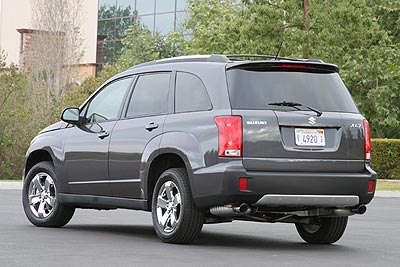
Fun to Drive
The XL7’s drag-race winning powertrain is its biggest source of fun. If you don’t mind squealing your tires for a second and can tolerate the racket, you can blow away pretty much any snoozing driver at a stop light to get that primo spot 100 yards away at the next signal. Otherwise, there’s not a lot of fun here. The engine is unacceptably loud if you’re over 25 years old, the handling is only so-so, and as a front driver, anything more challenging than a light snow is off limits. Less noise and a higher level of refinement would enhance the fun factor, or at the very least, a price well below $30,000 would make the XL7’s sins more forgivable.
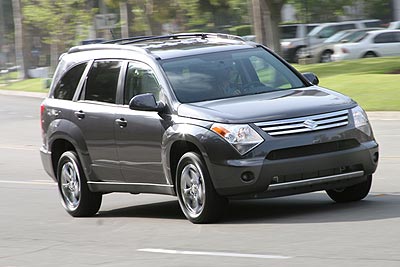
Front Comfort
One of the XL7’s strengths is comfort. The front seats are firm and very supportive for long stints. The steering wheel is wrapped in leather and features remote controls for the sound system. Yet even with one of its strengths there’s a serious weakness: While the seat’s fore, aft and height adjustments are power, the manual seatback lever is squeezed tightly between the door panel and the seat. The cheap plastic surrounding the seat bottom flexes when someone’s sitting in it, so the handle in our test car got stuck, allowing the seatback to flop back and forth until the handle was forced back in place. The potential safety hazard is obvious if you’re adjusting your seat while driving.
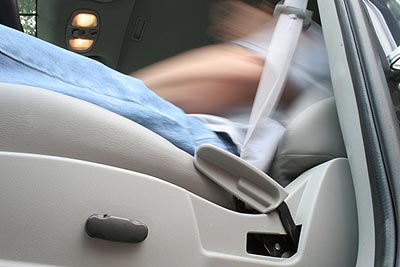
Rear Comfort
The XL7 offers a surprising amount of room in the second row, and is one of the vehicle’s unqualified high points. The theater seating arrangement puts the passengers’ heads above the front row occupants, and there is plenty of head, leg, foot and shoulder room for two people (three is cramped), even with the reclining seatback in its upright position. Though stretched nearly 10 inches longer than the Chevrolet Equinox, we’re not sure if the XL7’s third row of seats was worth the effort. It’s hard to access thanks to the narrow door opening and fiddly two-step folding second row, and there’s only adequate head room; you’ll have to cut off your legs to get truly comfortable.
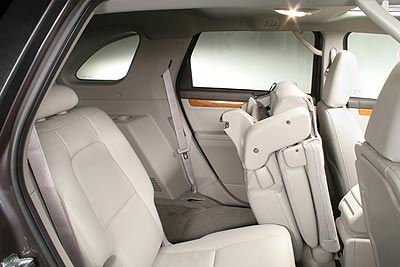
Interior Noise
Noises of all kinds echo through the XL7’s cabin. There’s the ever-present engine noise, which is at best a background irritant, but intrusive at wide open throttle. There’s noticeable tire rumble on most surfaces, and we heard a few suspension clunks on things like speed bumps and sharp driveway entrances. The outside mirrors are a huge source of wind noise at highway speeds. There’s also the quivering body, which generates its own resonance at times. Throw in a rattle coming from the passenger’s side and you have a noisy ride that requires a cranked sound system to quell.
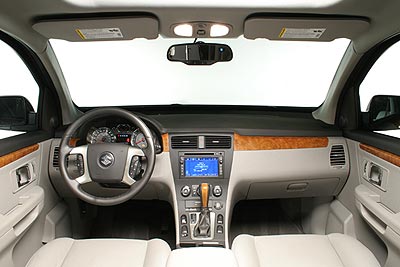
Loading Cargo
Compact crossovers like the XL7 don’t boast huge amounts of room, but the XL7’s narrow opening and load floor make things worse than some of its competitors. On the plus side there is usable space behind the third row, a claim many three-row SUVs can’t make. The third row folds easily once you remove the headrests and store them in the handy under-floor compartment, which can also hold purses, camera bags or other small items you want to keep out of sight. The second row folds quickly as well, and the front passenger seat also folds flat if you need to haul really long objects.

Build Quality
The actual parts in the XL7 are put together with moderate attention to detail, and while there was no single glaring fault there were numerous smaller misalignments that contributed to an overall junky feel inside. For example, the transition from the center stack to the center console was not flush, there were slightly misaligned panels on the center stack itself, the faux wood trim had noticeable gaps between it and the dash, and there were places where pillar covers didn’t fit properly against the headliner. Outside things were better. The gaps in the sheetmetal were consistent and small for the most part, and there were only a few minor misalignments between the fenders and doors.
